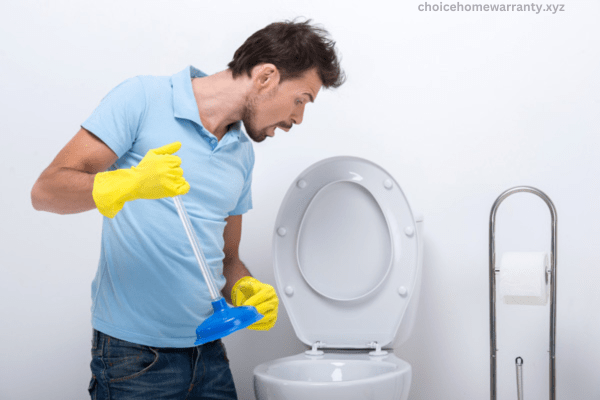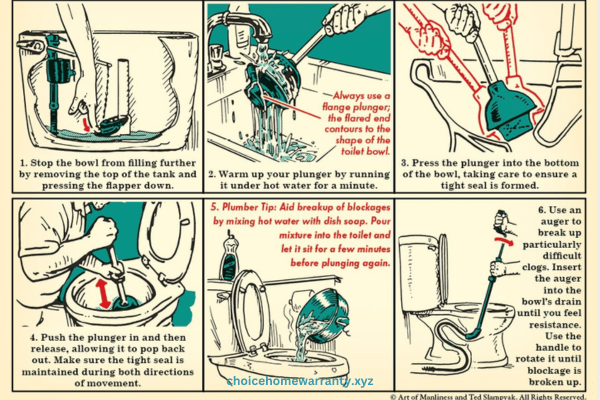Undeniably, knowing how to fix a clogged toilet with a plunger is an invaluable life skill that can save you from unanticipated messes and costly plumbing bills. The task often carries the illusion of being daunting and off-putting, yet it’s surprisingly straightforward when conducted systematically.
The magic of unclogging commences by slowly immersing the plunger into the toilet bowl to expel air and fill with water. Ideally, this helps create a hermetic seal around the orifice at the bottom of the bowl. Rapid forceful thrusts would further push the obstacle down while sucking motions yank it upwards. In quintessence, alternating these actions in rapid succession disintegrates blockages; seemingly conjuring magic and delivering your toilet back to its optimum function again. Knowing how to fix a clogged toilet with a plunger empowers you to reclaim control over your restroom’s tranquility, and truly, there’s no understating that relief.
Identification of Toilet Clog Causes
Identifying the causes of a toilet clog is an essential step in maintaining a well-functioning bathroom. Common causes can include flushing inappropriate items such as paper towels, sanitary products, or even toys. Once the cause is identified, fixing a clogged toilet often involves using a plunger. This simple tool creates pressure that dislodges the blockage, allowing water to flow freely once again. Properly using a plunger can save you from unnecessary plumbing expenses and maintain the cleanliness and functionality of your toilet.
Necessary Tools for Unclogging Toilets
The necessary tools for unclogging toilets primarily include the plunger, which is undoubtedly the star of the show. Depending on the shape of your toilet, you need to choose the right type of plunger; a cup plunger works best for flat surfaces, while a flange plunger is ideal for toilets with irregular shapes. Besides this essential tool, it is advisable to have rubber gloves, a bucket, and a mild cleaning solution on hand. With these items readily available, you can efficiently fix a clogged toilet using a plunger.
Preparation
Before diving into the task of fix a clogged toilet with a plunger, it is imperative to prepare your workspace adequately. Establishing a clean and safe workspace involves laying down towels around the area, which will help in absorbing any water spills. Furthermore, wearing gloves not only protects your hands but also ensures hygiene during the process. Always ensure that the workspace is well-lit to avoid accidents or missing any crucial steps. For a smooth operation without interruptions, gather all necessary tools and materials beforehand.
Identifying Toilet Types
Identifying different types of toilets is an essential step when it comes to fix a clogged toilet with a plunger. The type of toilet you have can greatly influence the method and tools used for unclogging. There are many types including gravity-feed, pressure-assisted, dual-flush, and double-cyclone, among others. Once you’ve identified your toilet type, you can proceed to use a plunger to resolve the clog. This process involves creating a vacuum that dislodges the obstruction, enabling smooth flow once again.
Types of Plungers
There are various types of plungers, each designed with unique shapes and sizes that are suitable for specific types of clogs. Understanding the different kinds of plungers available is the initial step in selecting the appropriate tool for unclogging a drain or pipe. Notably, there is a specific type of plunger designed for fixing a clogged toilet, showcasing the importance of knowing which plunger to use for each job.
Cup Plungers
Cup plungers are the most frequently used type of plunger and are easily recognizable by their rubber cup which forms a seal over the drain. This design makes them versatile and suitable for various applications, such as unclogging sinks and bathtubs. Moreover, they can be effectively used to fix a clogged toilet, thus proving an indispensable tool for any household plumbing issues.
Flange Plungers
Flange plungers, characterized by an extended rubber flap, are the perfect tool for dealing with clogged toilets. The unique design of the flange is especially suited to create a proper seal within the curved drain of a toilet bowl. This allows for efficient unclogging and resolving any issues related to blockages in your bathroom plumbing system. Therefore, fixing a clogged toilet becomes an easier task when you have a flange plunger at hand.
Accordion Plungers
Accordion plungers are specifically designed for sinks and drains that have irregular shapes. The unique accordion-style cup offers flexibility, which makes it much simpler to create a seal around the drain. This innovative design allows these types of plungers to effectively fix clogged toilets, providing a practical alternative solution when a regular plunger just won’t do the job.

Choosing the Right Plunger
Choosing the right plunger is an essential step to effectively deal with different types of clogs. The nature of the clog should guide your selection process to ensure that you get the most suitable plunger for the job. Furthermore, it’s crucial to understand the features of each plunger such as cup size and flange length, as these determine its effectiveness in creating a seal and producing maximum suction needed to unclog. Therefore, if you have a clogged toilet, knowing how to match your plunger type with the kind of clog can make the task more manageable and efficient.
Proper Plunger Selection
Selecting the proper plunger is crucial as not all plungers are created equal. Cup plungers tend to work best for flat surfaces, whereas flange plungers have been specifically designed to accommodate toilets with irregular shapes. It’s important to ensure there is a proper seal between the plunger and the drain to maximize its effectiveness. Therefore, whether you’re fixing a clogged toilet or dealing with other plumbing issues, choosing the right plunger can make all the difference.
Positioning the Plunger
To successfully unclog a toilet using a plunger, it is crucial to correctly position the plunger and achieve a proper seal. Firstly, place the plunger over the drain making sure that it fully covers the opening. This is important because a tight seal is essential in creating the necessary suction for effectual unclogging. By observing this, you are setting yourself up for a successful and efficient toilet unclogging process using a plunger.
Plunging Technique
The plunging technique involves taking a deep breath and plunging with purpose. This is done by using a controlled, rhythmic motion, where you push and pull to create pressure which helps in dislodging the clog in the toilet. It’s important to repeat this process several times, making necessary adjustments to your technique as needed, until the clog is completely cleared. Thus, fix a clogged toilet with a plunger becomes an easy task if done correctly.

Dealing with Stubborn Clogs
Dealing with stubborn clogs can be a frustrating task. If the clog continues to persist, it may be necessary to consider various troubleshooting options. You might need to adjust your plunging technique or increase the water pressure in an attempt to dislodge the blockage. In some cases, combining the use of a plunger with other tools can also prove beneficial. However, if all these methods prove unsuccessful, it might be time to call in professional help to fix your clogged toilet.
Preventive Measures
Preventive measures can be taken to fix a clogged toilet using a plunger. Firstly, it is essential to have the right kind of plunger that fits well into the toilet bowl for effective unclogging. The plunger should create a seal on the drain hole. You need to push down gently at first to get the air out, then follow with more forceful pushes and pull up sharply, repeating this process until the water starts to drain. It’s also advisable not to flush repeatedly as it might overflow the bowl. If these methods fail, professional help may be required.
Common Mistakes and How to Avoid Them
One common mistake is trying to fix a clogged toilet without using a plunger, which often worsens the situation. Learning how to properly use a plunger can help you avoid this problem. To fix a clogged toilet with a plunger, start by placing it over the drain hole and pushing it down gently to create a seal. Then, rapidly push and pull the plunger while maintaining the seal to dislodge the clog. Remember, patience is key as it might take several attempts before your toilet functions normally again.
Environmental Considerations
When considering the environment, fixing a clogged toilet with a plunger is an efficient and eco-friendly solution. It doesn’t involve the use of harsh chemicals that can harm the ecosystem when they are flushed into the sewage system and eventually end up in water bodies. Instead, using a plunger relies on physical force to dislodge blockages, making it a safe method for both your household’s plumbing system and overall environmental health.
Emergency Solutions
When faced with a clogged toilet, the most common emergency solution to fix it is by using a plunger. This method requires minimal effort and can effectively clear out the blockage. The suction action of a plunger helps in dislodging the clog, restoring the normal flow of water. It’s an essential tool for every household as it provides an immediate remedy to such emergencies. It is crucial to know how to use it properly for maximum effectiveness.
DIY vs. Professional Help
When trapped in a situation with a clogged toilet, individuals often grapple between the decision to embark on a DIY fix or seek professional help. Both routes present their unique advantages and drawbacks. The DIY approach, such as using a plunger to unclog the toilet, is usually cost-effective and offers immediate relief if successful. However, it might be messy and requires some level of skill and patience. On the other hand, resorting to professional help ensures that the job gets done correctly and thoroughly although it may come at a higher cost and might not provide instant results depending on the plumber’s availability.
Conclusion
fix a clogged toilet with a plunger is a simple task that can save you from costly plumbing services. The key is to ensure that you have the right tools and the correct technique for effective plunging. Remember, patience and consistency are crucial during this process. Don’t be discouraged if the first attempt doesn’t yield immediate results. As a call to action, next time your toilet gets clogged, don’t panic or rush to call a plumber; instead, grab your plunger and put these tips into practice!

FAQs About Fix a Clogged Toilet With a Plunger
Can I use any plunger to unclog my toilet?
While most plungers work, it’s recommended to use a flange plunger for toilets to ensure a better seal.
How often should I perform preventive maintenance on my toilet?
Regular preventive measures, such as enzyme treatments, should be done monthly to avoid clogs.
What should I do if the toilet remains clogged after multiple attempts?
If your efforts fail, it’s time to call a professional plumber to assess and fix the issue.
Are chemical drain cleaners safe for toilets?
It’s best to avoid chemical drain cleaners as they can damage your plumbing and harm the environment.
Can I use the same plunger for different toilets in my house?
It’s advisable to have separate plungers for each toilet to prevent cross-contamination.
